Study of Cyberbullying among Adolescents in Recent Years: A Bibliometric Analysis
Abstract
1. Introduction
2. Materials and Methods
2.1. Selecting the Database
2.2. Data Collection and Search Strategy
2.3. Inclusion and Exclusion Criteria
2.4. Data Analysis
3. Results
4. Discussion
5. Conclusions
Author Contributions
Funding
Institutional Review Board Statement
Informed Consent Statement
Data Availability Statement
Acknowledgments
Conflicts of Interest
References
- Mateo, C.M.; Hernández, M.P.; Cabrero, R.S. El bienestar psicológico en la adolescencia: Variables psicológicas asociadas y predictoras. Eur. J. Educ. Psychol. 2019, 12, 139. [Google Scholar] [CrossRef]
- Linares, J.J.G.; Pérez-Fuentes, M.D.C.; Martínez, J.J.C.; de la Rosa, A.L.; Jurado, M.D.M.M. Interpersonal Value Profiles and Analysis to Adolescent Behavior and Social Attitudes: Perfiles de valores interpersonales y análisis de conductas y actitudes sociales de adolescentes. Rev. Psicodidáctica 2015, 20, 321–337. [Google Scholar] [CrossRef]
- Pérez-Fuentes, M.C.; Álvarez-Bermejo, J.A.; Molero, M.M.; Gázquez, J.J.; López, M.A. Scholar violence and academic achievement (VERA): Augmented Reality Application. Eur. J. Investig. Health Psychol. Educ. 2011, 1, 71–84. [Google Scholar] [CrossRef]
- Romero-Abrio, A.; Martínez-Ferrer, B.; Sánchez-Sosa, J.C.; Musitu, G. A psychosocial analysis of relational aggression in Mexican adolescents based on sex and age. Psicothema 2019, 31, 88–93. [Google Scholar]
- Álvarez-García, D.; García, T.; Núñez, J.C. Predictors of school bullying perpetration in adolescence: A systematic review. Aggress. Violent Behav. 2015, 23, 126–136. [Google Scholar] [CrossRef]
- Linares, J.J.G.; Díaz, A.J.C.; Fuentes, M.D.C.P.; Acién, F.L.; Cangas, A.J. Teachers’ perception of school violence in a sample from three european countries. Eur. J. Psychol. Educ. 2009, 24, 49–59. [Google Scholar] [CrossRef]
- Abuín-Vences, N.; Maestro-Espínola, L.; Cordón-Benito, D. Internet, smartphones y redes sociales como factores determinan-tes en el incremento de casos de ciberacoso = Internet, smartphones and social networks as determining factors in the increase in cyberbullying cases. Rev. Espac. 2019, 40, 23. [Google Scholar]
- Dominguez-Alonso, J.; Vazquez-Varela, E.; Nuñez-Lois, S. Cyberbullying escolar: Incidencia del teléfono móvil e internet en adolescentes. RELIEVE Rev. Electrónica Investig. Eval. Educ. 2017, 23, 1–11. [Google Scholar] [CrossRef]
- Craig, W.; Harel-Fisch, Y.; Fogel-Grinvald, H.; Dostaler, S.; Hetland, J.; Simons-Morton, B.; Molcho, M.; de Mato, M.G.; Overpeck, M.; Due, P.; et al. A cross-national profile of bullying and victimization among adolescents in 40 countries. Int. J. Public Health 2009, 54, 216–224. [Google Scholar] [CrossRef]
- World Health Organization. Global Status Report on Violence Prevention 2014. Available online: http://www.who.int/violence_injury_prevention/violence/status_report/2014/report/report/en/ (accessed on 26 January 2021).
- Fahy, A.E.; Stansfeld, S.A.; Smuk, M.; Smith, N.R.; Cummins, S.; Clark, C. Longitudinal Associations Between Cyberbullying Involvement and Adolescent Mental Health. J. Adolesc. Healeh 2016, 59, 502–509. [Google Scholar] [CrossRef] [PubMed]
- Olweus, D. Cyberbullying: An overrated phenomenon? Eur. J. Dev. Psychol. 2012, 9, 520–538. [Google Scholar] [CrossRef]
- Kowalski, R.M.; Giumetti, G.W.; Schroeder, A.N.; Lattanner, M.R. Bullying in the digital age: A critical review and meta-analysis of cyberbullying research among youth. Psychol. Bull. 2014, 140, 1073–1137. [Google Scholar] [CrossRef] [PubMed]
- Beltrán-Catalán, M.; Zych, I.; Ortega-Ruiz, R.; Lorent, V.J. Victimisation through bullying and cyberbullying: Emotional intelligence, severity of victimisation and technology use in different types of victims. Psicothema 2018, 30, 183–188. [Google Scholar] [PubMed]
- Gordillo, I.C.; Antelo, I.F.; Parra, G.M.-M.; Fernández-Antelo, I. Pueden las víctimas de bullying convertirse en agresores del ciberespacio? Estudio en población adolescente. Eur. J. Investig. Health Psychol. Educ. 2019, 9, 71–81. [Google Scholar] [CrossRef]
- Bottino, S.M.B.; Bottino, C.M.C.; Regina, C.G.; Correia, A.V.L.; Ribeiro, W.S. Cyberbullying and adolescent mental health: Systematic review. Cad. Saúde Pública 2015, 31, 463–475. [Google Scholar] [CrossRef]
- Aboujaoude, E.; Savage, M.W.; Starcevic, V.; Salame, W.O. Cyberbullying: Review of an Old Problem Gone Viral. J. Adolesc. Health 2015, 57, 10–18. [Google Scholar] [CrossRef] [PubMed]
- Lara-Beltrán, M.D. Afrontamiento, afecto y tabaco en una muestra de adolescentes españoles. Rev. Psicol. Clín. Niños Adolesc. 2019, 6, 9–14. [Google Scholar] [CrossRef]
- Handono, S.G.; Laeheem, K.; Sittichai, R. Factors related with cyberbullying among the youth of Jakarta, Indonesia. Child. Youth Serv. Rev. 2019, 99, 235–239. [Google Scholar] [CrossRef]
- Rodríguez-Hidalgo, A.J.; Solera, E.; Calmaestra, J. Psychological Predictors of Cyberbullying According to Ethnic-Cultural Origin in Adolescents: A National Study in Spain. J. Cross-Cult. Psychol. 2018, 49, 1506–1522. [Google Scholar] [CrossRef]
- Cañas, E.; Estévez, E.; Marzo, J.C.; Piqueras, J.A. Psychological adjustment in cybervictims and cyberbullies in secondary education. An. Psicol. 2019, 35, 434–443. [Google Scholar] [CrossRef]
- Martínez, I.; Murgui, S.; Garcia, O.F.; Garcia, F. Parenting in the digital era: Protective and risk parenting styles for traditional bullying and cyberbullying victimization. Comput. Hum. Behav. 2019, 90, 84–92. [Google Scholar] [CrossRef]
- Chu, X.-W.; Fan, C.-Y.; Liu, Q.-Q.; Zhou, Z.-K. Cyberbullying victimization and symptoms of depression and anxiety among Chinese adolescents: Examining hopelessness as a mediator and self-compassion as a moderator. Comput. Hum. Behav. 2018, 86, 377–386. [Google Scholar] [CrossRef]
- Livazović, G.; Ham, E. Cyberbullying and emotional distress in adolescents: The importance of family, peers and school. Heliyon 2019, 5, e01992. [Google Scholar] [CrossRef]
- Pengpid, S.; Peltzer, K. Bullying victimization and externalizing and internalizing symptoms among in-school adolescents from five ASEAN countries. Child. Youth Serv. Rev. 2019, 106, 104473. [Google Scholar] [CrossRef]
- Álvarez-García, D.; Núñez, J.C.; García, T.; Barreiro-Collazo, A.; Barreiro-Collazo, A.A. Individual, Family, and Community Predictors of Cyber-aggression among Adolescents. Eur. J. Psychol. Appl. Leg. Context 2018, 10, 79–88. [Google Scholar] [CrossRef]
- Llorca-Mestre, A.; Malonda-Vidal, E.; Samper-García, P. Prosocial reasoning and emotions in young offenders and non-offenders. Eur. J. Psychol. Appl. Leg. Context 2017, 9, 65–73. [Google Scholar] [CrossRef]
- Garcia-Hermoso, A.; Oriol-Granado, X.; Correa-Bautista, J.E.; Ramírez-Vélez, R. Association between bullying victimization and physical fitness among children and adolescents. Int. J. Clin. Health Psychol. 2019, 19, 134–140. [Google Scholar] [CrossRef]
- Perez-Gramaje, A.F.; Garcia, O.F.; Reyes, M.; Serra, E.; Garcia, F. Parenting Styles and Aggressive Adolescents: Relationships with Self-esteem and Personal Maladjustment. Eur. J. Psychol. Appl. Leg. Context 2019, 12, 1–10. [Google Scholar] [CrossRef]
- Moffitt, T.E. Male antisocial behaviour in adolescence and beyond. Nat. Hum. Behav. 2018, 2, 177–186. [Google Scholar] [CrossRef] [PubMed]
- Lee, Y.C.; Wu, W.-L. Factors in cyber bullying: The attitude-social influence-efficacy model. An. Psicol. 2018, 34, 324–331. [Google Scholar] [CrossRef]
- Lee, C.; Shin, N. Prevalence of cyberbullying and predictors of cyberbullying perpetration among Korean adolescents. Comput. Hum. Behav. 2017, 68, 352–358. [Google Scholar] [CrossRef]
- Zych, I.; Ortega-Ruiz, R.; del Rey, R. Systematic review of theoretical studies on bullying and cyberbullying: Facts, knowledge, prevention, and intervention. Aggress. Violent Behav. 2015, 23, 1–21. [Google Scholar] [CrossRef]
- De Bellis, N. Bibliometrics and Citation Analysis: From the Science Citation Index to Cybermetrics; Scarecrow Press Inc.: Lanham, MD, USA, 2009. [Google Scholar]
- Pan, X.; Yan, E.; Cui, M.; Hua, W. Examining the usage, citation, and diffusion patterns of bibliometric mapping software: A comparative study of three tools. J. Inf. 2018, 12, 481–493. [Google Scholar] [CrossRef]
- Herrera-López, M.; Romera, E.M.; Ortega-Ruiz, R. Bullying y Cyberbullying en Latinoamérica. Un estudio bibliométrico. = Bullying and Cyberbullying in Latin America. A bibliometric study. Rev. Mex. Investig. Educ. 2018, 23, 125–155. [Google Scholar]
- Cañón, R.; Grande, M.; Ferrero, E. Ciberacoso: Revisión de la literatura educativa en español. (Cyberbullying: A review of the educational literatura). RELATEC 2018, 17, 87–99. [Google Scholar] [CrossRef]
- Garaigordobil, M.; Martínez-Valderrey, V. Effects of Cyberprogram 2.0 on“face-to-face” bullying, cyberbullying, and empathy. Psicothema 2015, 27, 45–51. [Google Scholar]
- Morales, E. El smartphone como motor de una nueva incertidumbre social: La importancia de las redes sociales en la comuni-cación móvil de los jóvenes españoles en la sociedad de la inmediatez. = The smartphone as the engine of a new social uncer-tainty: The importance of social networks in the mobile communication of young Spanish people in the society of immediacy. Prism. Soc. 2012, 8, 87–115. [Google Scholar]
- Curry, M.J.; Lillis, T. Multilingual Scholars and the Imperative to Publish in English: Negotiating Interests, Demands, and Rewards. TESOL Q. 2004, 38, 663. [Google Scholar] [CrossRef]
- Anderson, E.L.; Steen, E.; Stavropoulos, V. Internet use and Problematic Internet Use: A systematic review of longitudinal research trends in adolescence and emergent adulthood. Int. J. Adolesc. Youth 2017, 22, 430–454. [Google Scholar] [CrossRef]
- Persson, O.R.; Danell, R.; Wiborg-Schneider, J. How to use Bibexcel for various types of bibliometric analysis. In Celebrating Scholarly Communication studies: A Festschrift for Olle Persson at his 60th Birthday; Åström, F., Danell, R., Larsen, B., Schneider, J., Eds.; International Society for Scientometrics and Informetrics: Leuven, Belgium, 2009; pp. 9–24. [Google Scholar]
- Batagelj, V.; Mrvar, A. Pajek—A program for large network analysis. Connections 1998, 21, 47–57. [Google Scholar]
- Van Eck, N.J.; Waltman, L. VOSviewer Manual [en Línea]. Available online: https://www.vosviewer.com/documentation/Manual_VOSviewer_1.5.5.pdf (accessed on 5 December 2013).
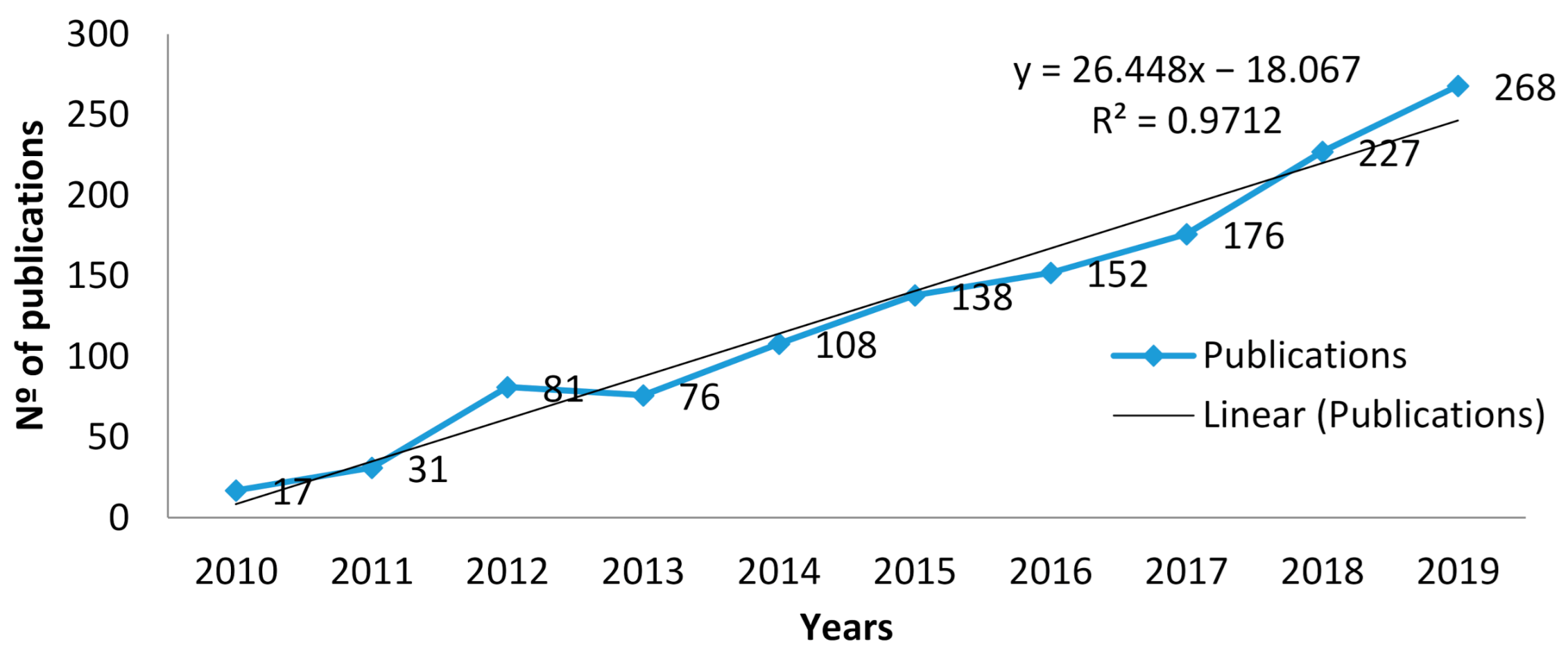
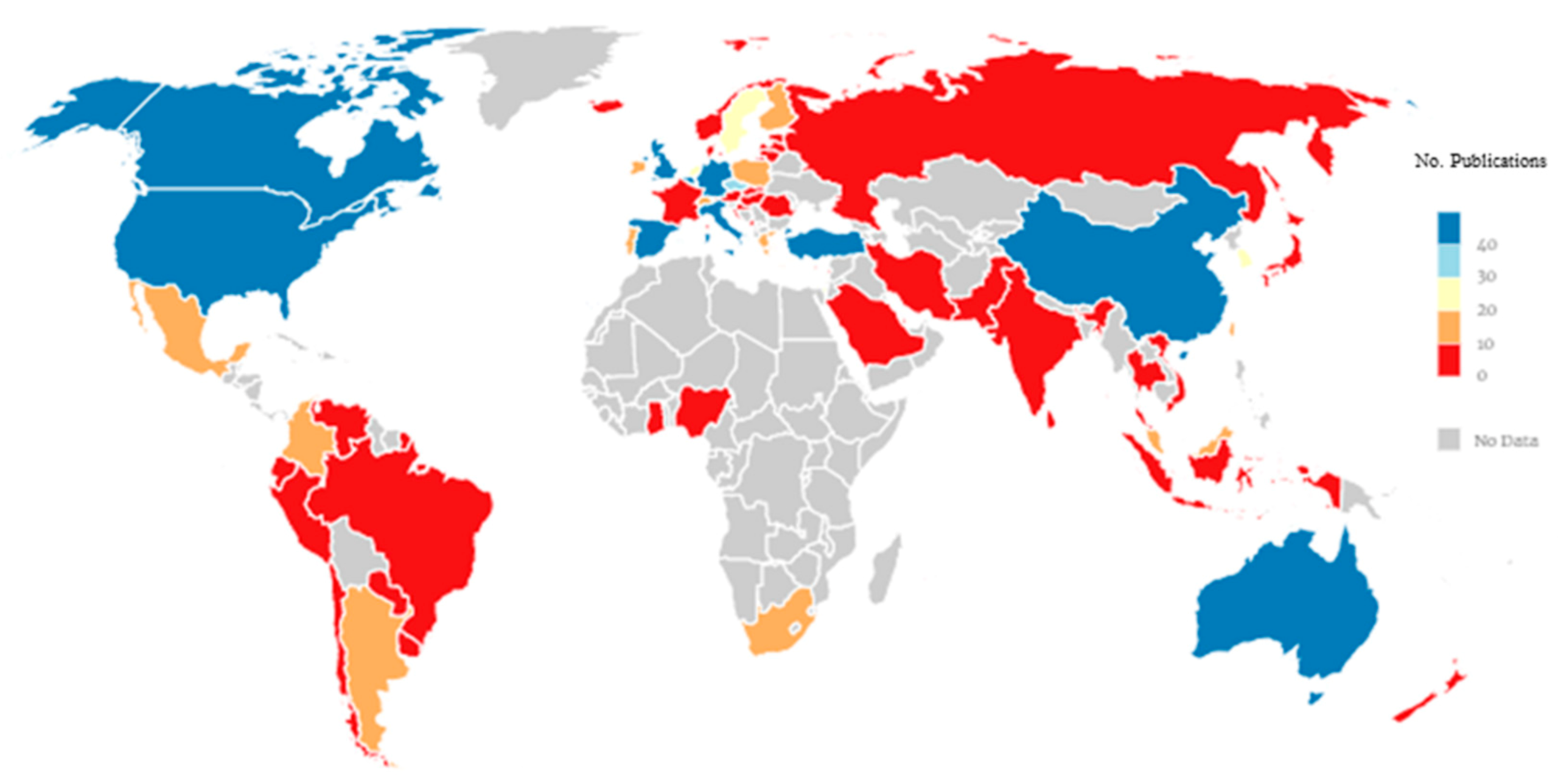
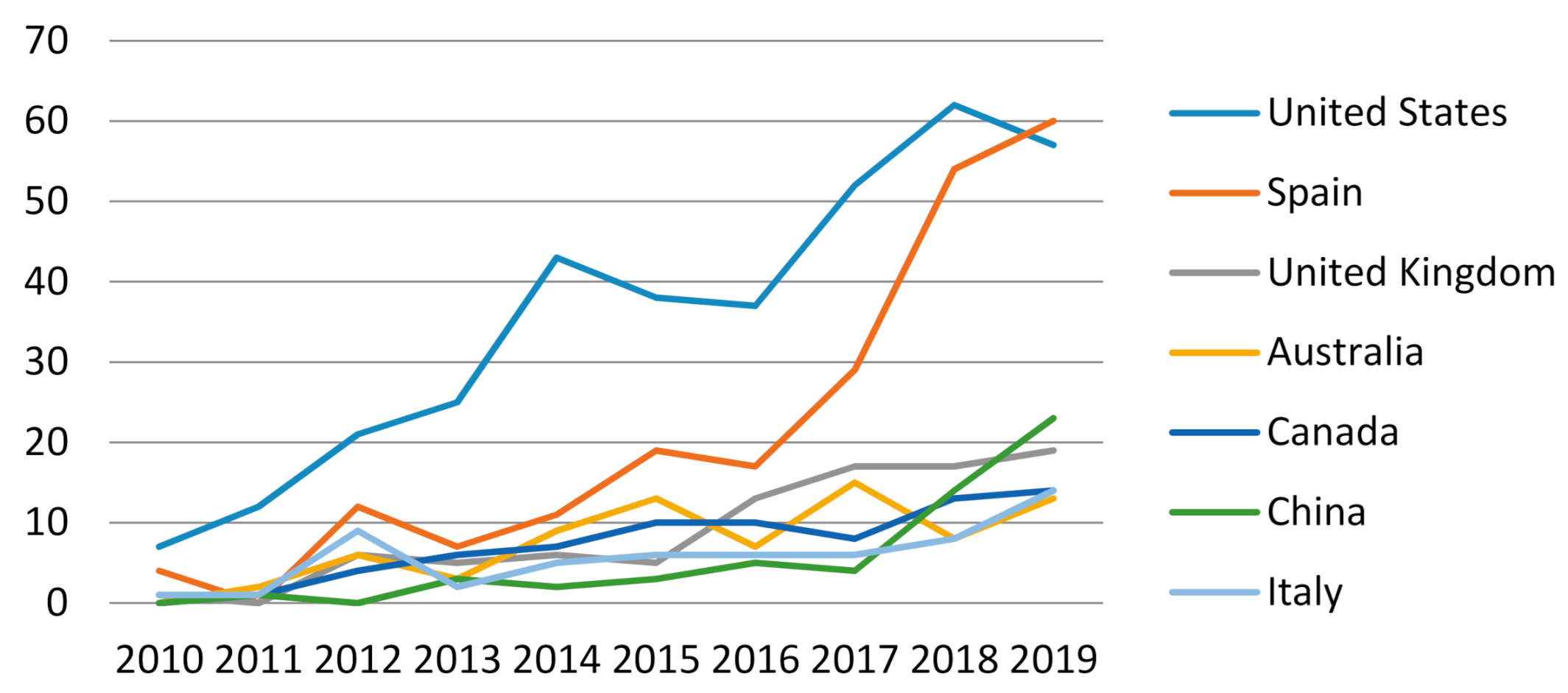
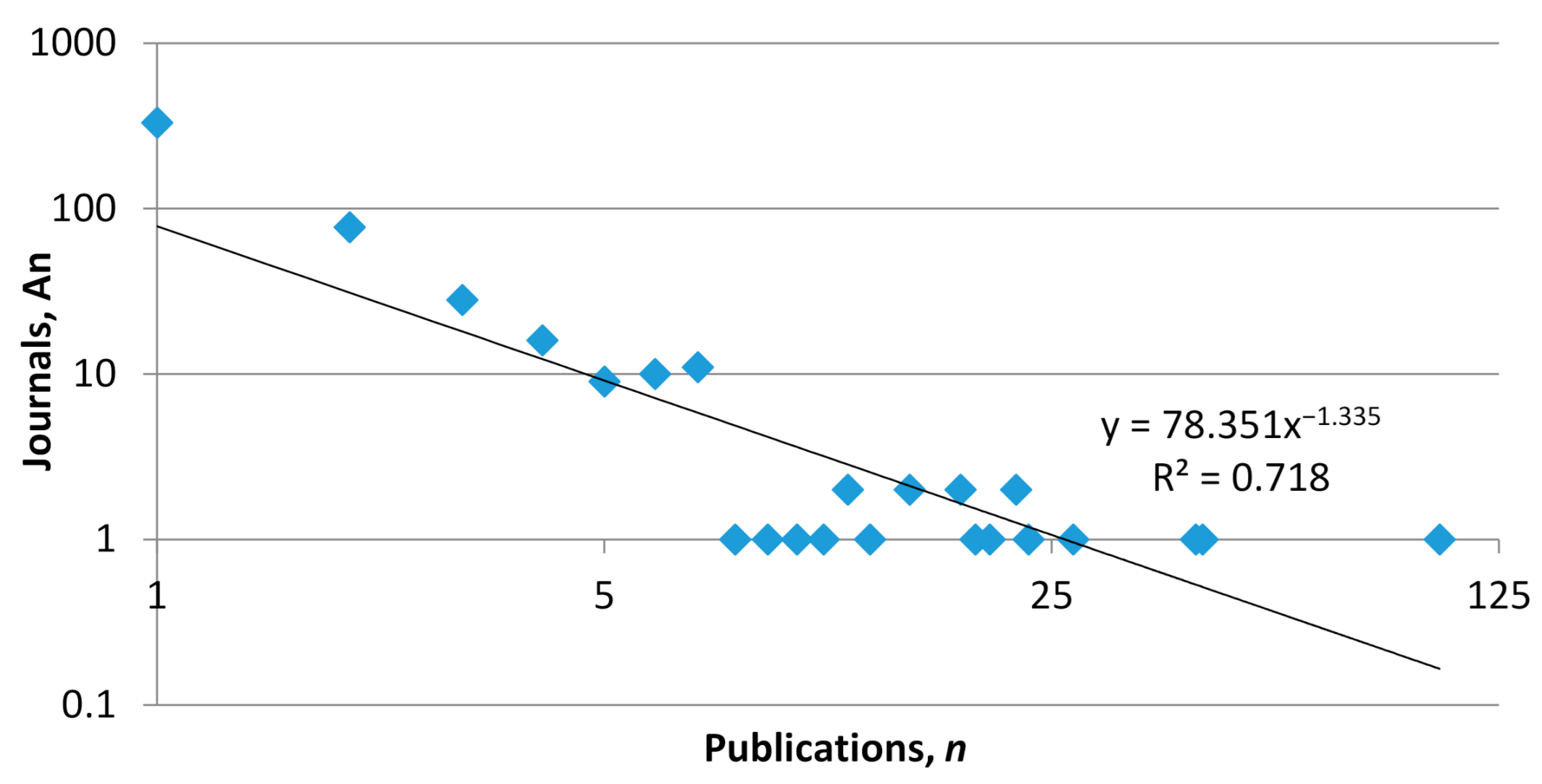
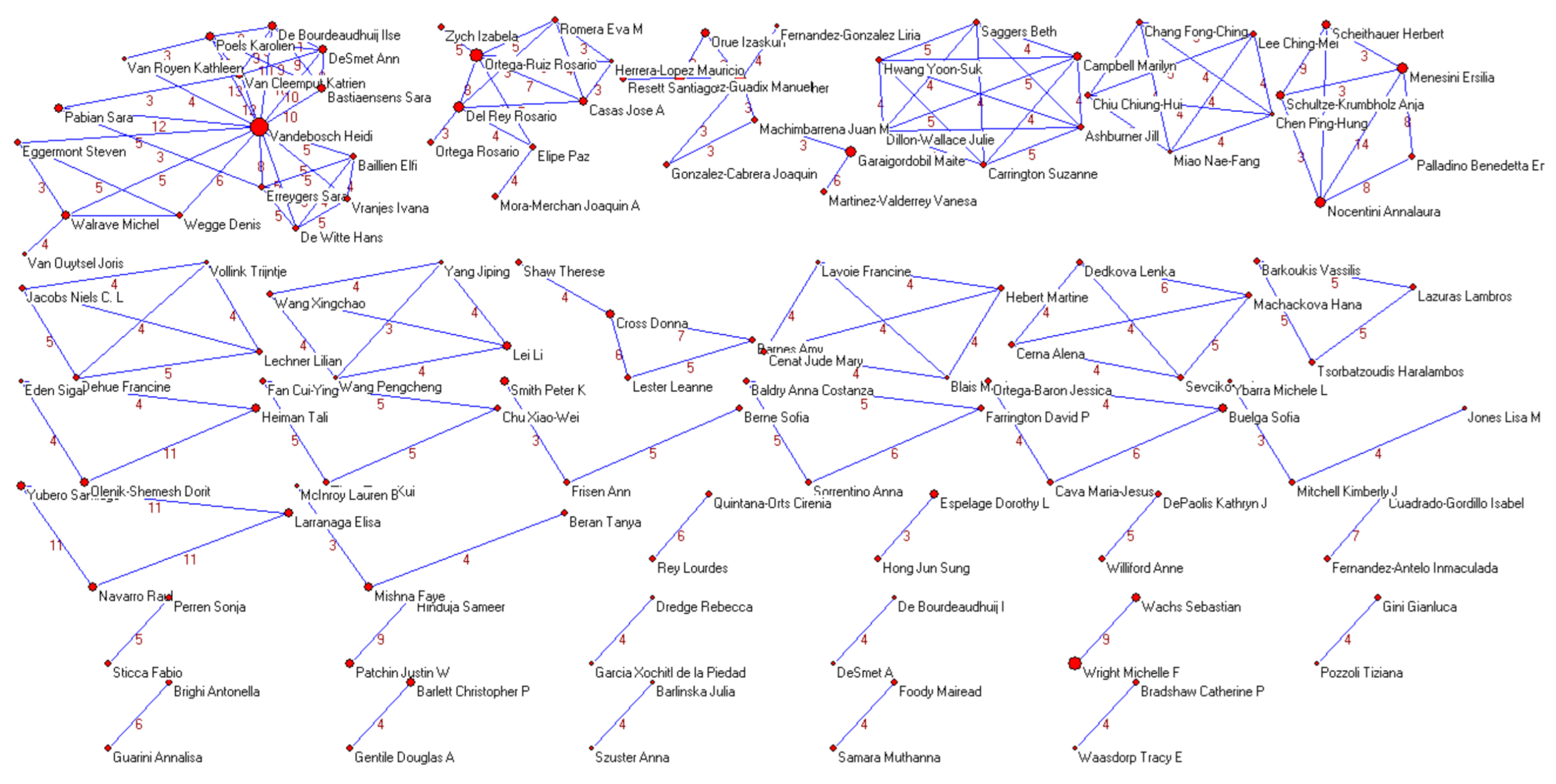

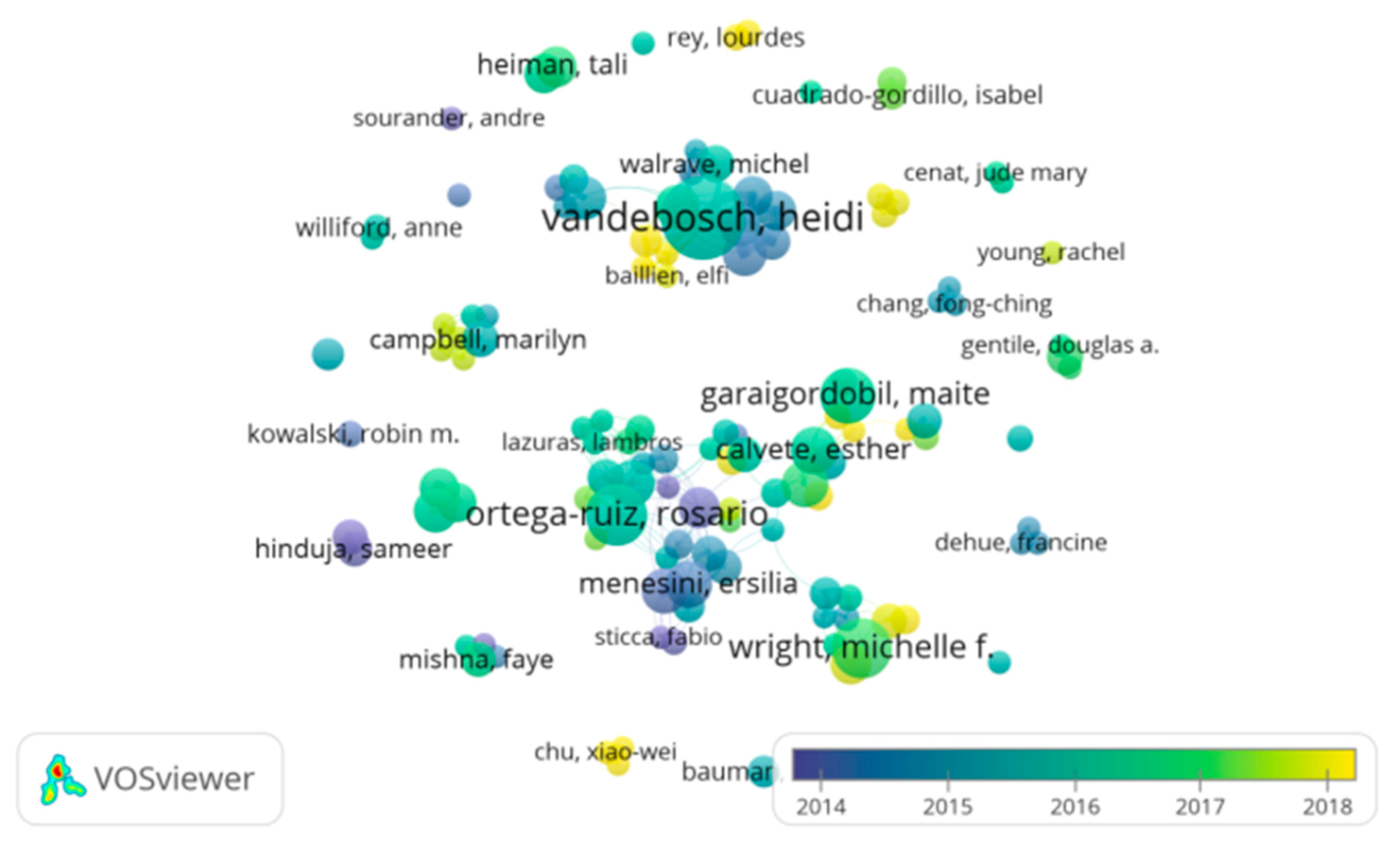
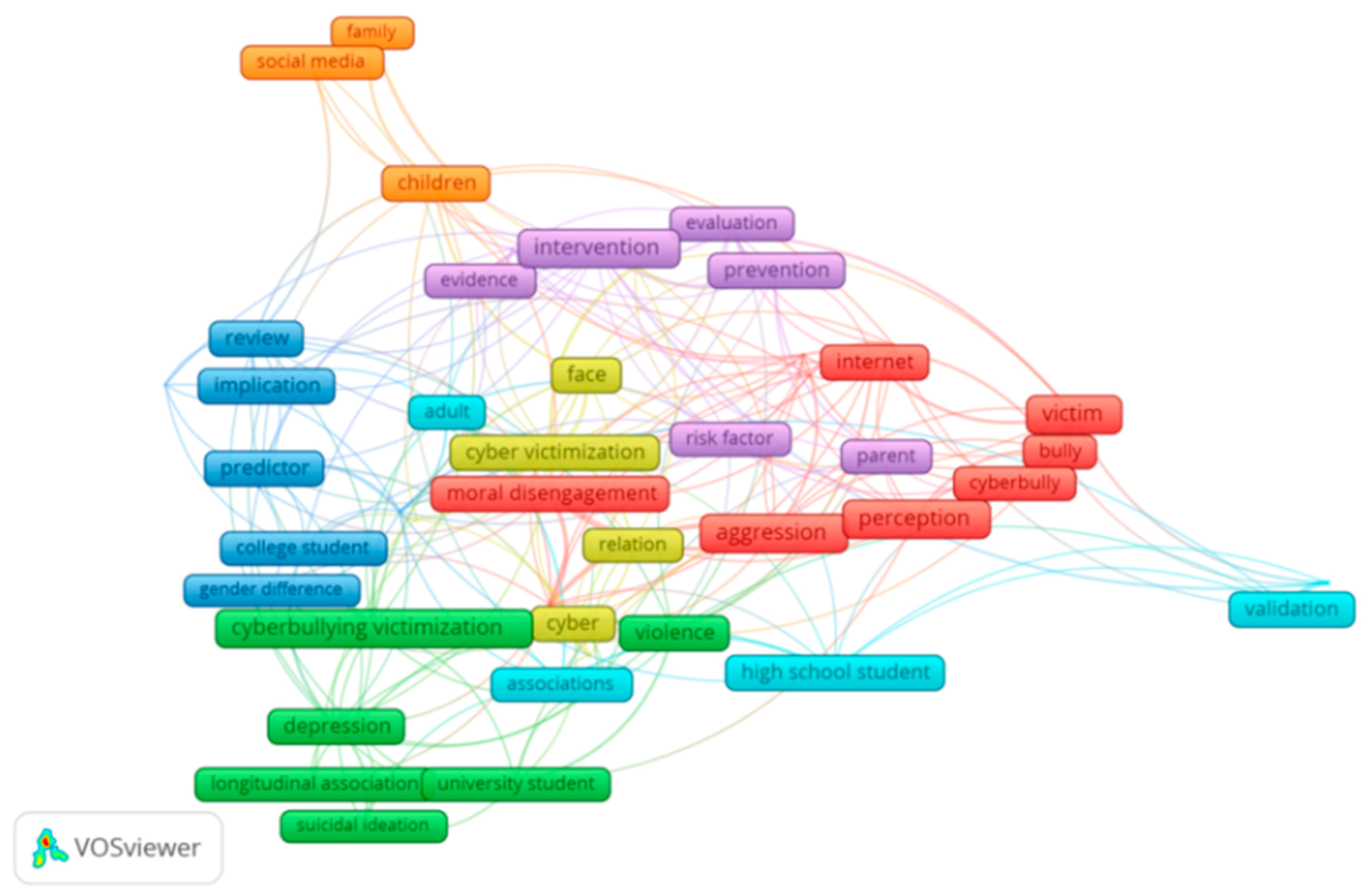
| Journal | No. of Publications | Quartile | SJR (2018) | H Index | Country |
|---|---|---|---|---|---|
| Computers in Human Behavior | 101 | Q1 | 1.71 | 137 | United Kingdom |
| Cyberpsychology, Behavior, and Social Networking | 43 | Q1 | 1.31 | 119 | United States |
| International Journal of Environmental Research and Public Health | 42 | Q2 | 0.82 | 78 | Switzerland |
| Journal of Interpersonal Violence | 27 | Q1 | 1.17 | 93 | United States |
| Aggressive Behavior | 23 | Q1 | 1.47 | 82 | United States |
| Frontiers in Psychology | 22 | Q1 | 1 | 81 | Switzerland |
| Journal of Adolescence | 22 | Q1 | 1.09 | 101 | United States |
| Children and Youth Services Review | 20 | Q1 | 0.75 | 77 | United Kingdom |
| Journal of School Violence | 19 | Q1 | 1.09 | 32 | United States |
| Journal of Adolescent Health | 18 | Q1 | 2.35 | 142 | Netherlands |
| Journal of Youth and Adolescence | 18 | Q1 | 1.52 | 101 | Netherlands |
| Psicothema | 15 | Q2 | 0.64 | 47 | Spain |
| BMC Public Health | 15 | Q1 | 1.38 | 117 | United Kingdom |
| Violence and Victims | 13 | Q1 | 0.57 | 76 | United States |
| Journal of Youth Studies | 12 | Q1 | 1 | 46 | United States |
| School Psychology International | 12 | Q2 | 0.62 | 49 | United States |
| Comunicar | 11 | Q1 | 0.85 | 26 | Spain |
| Journal of School Health | 10 | Q1 | 0.86 | 75 | United States |
| Author | Documents | Citations | Total Bond Strength |
|---|---|---|---|
| Vandebosch, Heidi | 37 | 518 | 107 |
| Ortega-Ruiz, Rosario | 28 | 803 | 57 |
| Wright, Michelle F. | 22 | 197 | 15 |
| Garaigordobil, Maite | 19 | 253 | 10 |
| Menesini, Ersilia | 15 | 570 | 35 |
| Calvete, Esther | 15 | 589 | 22 |
| Gamez-Guadix, Manuel | 15 | 372 | 15 |
| Nocentini, Annalaura | 14 | 513 | 35 |
| Del Rey, Rosario | 14 | 331 | 31 |
| Poels, Karolien | 13 | 300 | 53 |
| Pabian, Sara | 13 | 210 | 29 |
| Navarro, Raul | 13 | 199 | 22 |
| Smith, Peter K. | 12 | 930 | 20 |
| Van Cleemput, Katrien | 12 | 331 | 53 |
| Heiman, Tali | 12 | 159 | 11 |
| Wachs, Sebastian | 12 | 70 | 11 |
| De Bourdeaudhuij, Ilse | 11 | 290 | 50 |
| Desmet, Ann | 11 | 290 | 50 |
| Olenik-Shemesh, Dorit | 11 | 159 | 11 |
| Larranaga, Elisa | 11 | 142 | 22 |
| Yubero, Santiago | 11 | 142 | 22 |
| Bastiaensens, Sara | 10 | 276 | 50 |
| Walrave, Michel | 10 | 253 | 13 |
| Casas, Jose A. | 10 | 228 | 27 |
| Barlett, Christopher P. | 10 | 100 | 5 |
| Campbell, Marilyn | 10 | 88 | 17 |
| Hinduja, Sameer | 9 | 1158 | 9 |
| Patchin, Justin W. | 9 | 1158 | 9 |
| Orue, Izaskun | 9 | 517 | 14 |
| Scheithauer, Herbert | 9 | 344 | 23 |
| Schultze-Krumbholz, Anja | 9 | 344 | 23 |
| Buelga, Sofia | 9 | 197 | 10 |
| Espelage, Dorothy I. | 9 | 174 | 6 |
| Lei, Li | 9 | 56 | 12 |
| Mishna, Faye | 9 | 54 | 8 |
Publisher’s Note: MDPI stays neutral with regard to jurisdictional claims in published maps and institutional affiliations. |
© 2021 by the authors. Licensee MDPI, Basel, Switzerland. This article is an open access article distributed under the terms and conditions of the Creative Commons Attribution (CC BY) license (http://creativecommons.org/licenses/by/4.0/).
Share and Cite
Barragán Martín, A.B.; Molero Jurado, M.d.M.; Pérez-Fuentes, M.d.C.; Simón Márquez, M.d.M.; Martos Martínez, Á.; Sisto, M.; Gázquez Linares, J.J. Study of Cyberbullying among Adolescents in Recent Years: A Bibliometric Analysis. Int. J. Environ. Res. Public Health 2021, 18, 3016. https://doi.org/10.3390/ijerph18063016
Barragán Martín AB, Molero Jurado MdM, Pérez-Fuentes MdC, Simón Márquez MdM, Martos Martínez Á, Sisto M, Gázquez Linares JJ. Study of Cyberbullying among Adolescents in Recent Years: A Bibliometric Analysis. International Journal of Environmental Research and Public Health. 2021; 18(6):3016. https://doi.org/10.3390/ijerph18063016
Chicago/Turabian StyleBarragán Martín, Ana Belén, María del Mar Molero Jurado, María del Carmen Pérez-Fuentes, María del Mar Simón Márquez, África Martos Martínez, Maria Sisto, and José Jesús Gázquez Linares. 2021. "Study of Cyberbullying among Adolescents in Recent Years: A Bibliometric Analysis" International Journal of Environmental Research and Public Health 18, no. 6: 3016. https://doi.org/10.3390/ijerph18063016
APA StyleBarragán Martín, A. B., Molero Jurado, M. d. M., Pérez-Fuentes, M. d. C., Simón Márquez, M. d. M., Martos Martínez, Á., Sisto, M., & Gázquez Linares, J. J. (2021). Study of Cyberbullying among Adolescents in Recent Years: A Bibliometric Analysis. International Journal of Environmental Research and Public Health, 18(6), 3016. https://doi.org/10.3390/ijerph18063016












